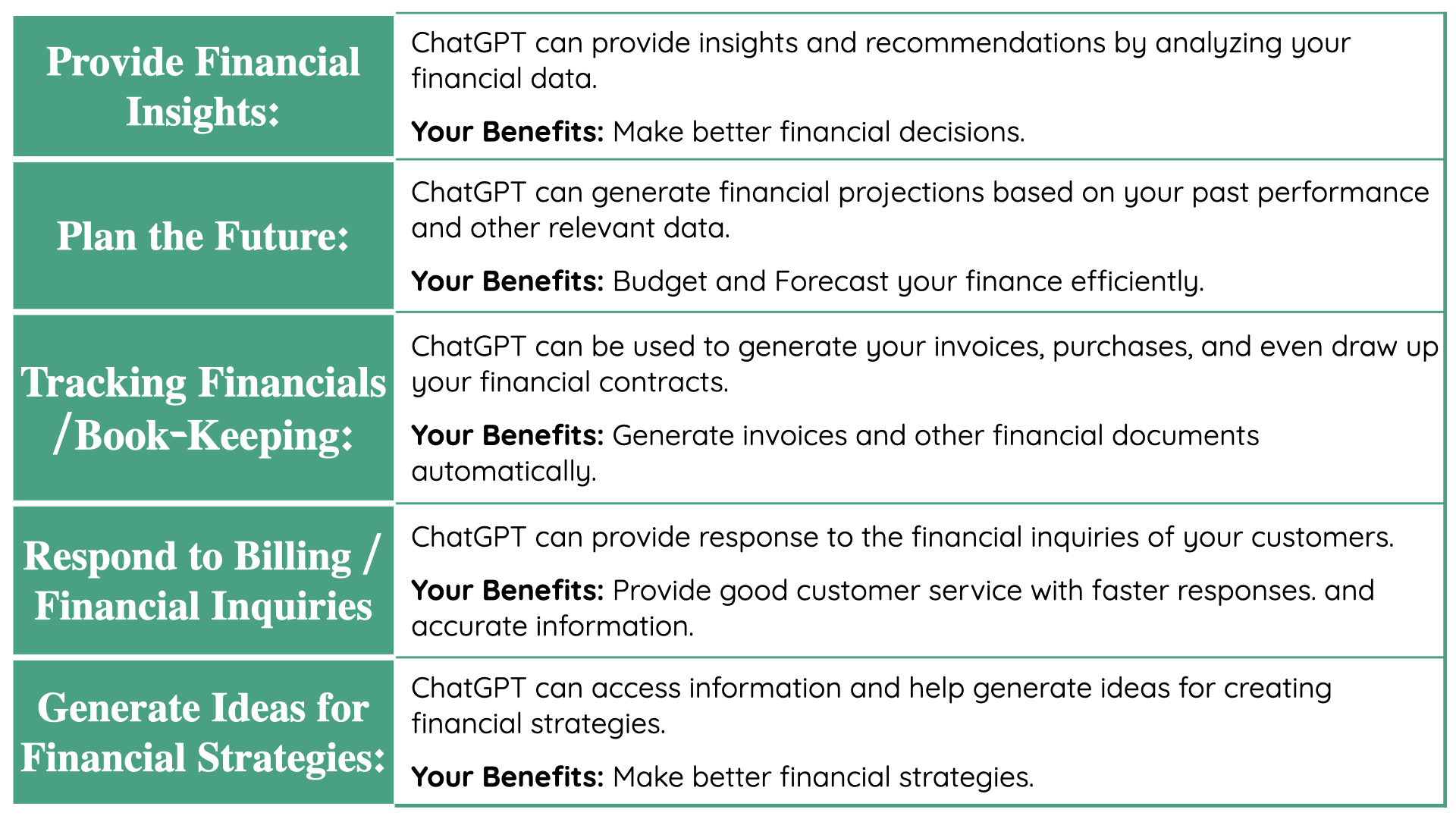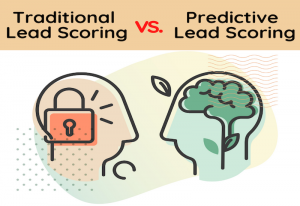What is a ChatGPT?
ChatGPT or the Chat Generative Pre-trained Transformer is known for its detailed responses and articulate answers across many domains of knowledge. It has been the talk of the town ever since its introduction in November 2022.
The first thing that we have to be aware of is that ChatGPT is not an all encompassing solution to a business problem. Just like in case of any other technology initiative, one has to start by understanding what business problem needs to be solved. Then one needs to design a UI – UX wrapper, write front end / back end software code and build DB structures in order to create a product that can fully harness ChatGPT for a specific business use case.
The key to using ChatGPT effectively is to understand exactly what its capabilities and limitations are. In this article we talk about a few use cases for ChatGPT to add value to the world of finance. The possibilities of ChatGPT in finance are enormous and some of them are listed below.

I. Provide Financial Insights

You can use ChatGPT to generate reports highlighting key trends and insights and then use it to analyze this financial data. In other words, give a dataset of financial data to ChatGPT and then ask it to generate a report summarizing the key trends and recommendations for decision-making.
Here are a few ways how ChatGPT can be potentially used to help with financial analysis and decision-making.
- Generate reports and summaries:
ChatGPT can be used to generate reports or summaries of financial data highlighting key trends and insights. This allows for quick interpretation of large data and discovery of patterns that are difficult to spot manually.The steps to follow are:
- Start aggregating the financial data that you need to analyze. You can do it using a spreadsheet with data like sales, expenses, profits etc.
- Open a Terminal window (for MacOs / Linus) or Command Prompt (for Windows OS) and start ChatGPT by running the command:
python -m openai.ChatGPT
-
- When the ChatGPT application opens, provide it with a prompt to generate reports or summaries by typing “Please summarize the financial data for the past year, highlighting any key trends or insights.”
- ChatGPT with its language generation capabilities will analyze the financial data and then generate a report or summary highlighting any important trends or insights. ChatGPT can also answer follow-up questions to get more detailed information or clarify any points.
Here are a few examples of ChatGPT generated financial summaries –
Example 1:
For the past quarter, the company generated total revenues of $X million, resulting in a profit of $Y million. Major expenses included employee salaries, rent, and advertising costs, which totaled $Z million. The company’s profits were also impacted by one-time charges such as legal fees and restructuring costs, which totaled $A million.”
Example 2:
“Over the past five years, the company’s revenues have grown steadily, reaching a high of $F million in year X and a low of $G million in year Y. During this time period, the company’s profits have also fluctuated, reaching a high of $H million in year X and a low of $I million in year Y. Major expenses have remained relatively consistent over this time period, with employee salaries, rent, and advertising costs accounting for a significant portion of the company’s expenses.”
Example 3:
“Compared to its main competitors in the same industry, the company has consistently outperformed in terms of revenues and profits. Over the past year, the company generated revenues of $J million, while competitor A generated revenues of $K million and competitor B generated revenues of $L million. The company also had a higher profit margin, with profits of $M million compared to competitor A’s profits of $N million and competitor B’s profits of $O million. However, the company’s expenses were slightly higher, with employee salaries, rent, and advertising costs totaling $P million compared to competitor A’s expenses of $Q million and competitor B’s expenses of $R million.”
-
Provide financial recommendations:
ChatGPT can be used to provide recommendations for financial or investment strategies based on the data it has been trained on. You can use ChatGPT to analyze a company’s financial data and then suggest whether it would be a good investment based on its performance and other factors.You can start requesting recommendations for investment decisions or other financial strategies by providing the respective prompts.
Now, you can start asking followup questions about the company or the investment strategy you are considering. ChatGPT will use its knowledge and training to provide recommendations and insights.
- Identifying risks & opportunities:
ChatGPT can also be used to identify the risks or opportunities in financial data that might not seem obvious otherwise. For instance, you can use it to analyze a company’s financial statements and identify potential problems that could impact its performance in the future by feeding ChatGPT with a dataset of a company’s financial statements and then ask it to identify the potential problems. The model might identify issues such as declining revenues, increasing expenses, or declining profit margins.
You can start identifying risks in financial data by asking guided questions on the financial data. ChatGPT can provide a list of potential risks to look for in a company’s financial statements, such as: :
- High levels of debt: If a company has a high level of debt relative to its assets or income, it may be at risk of defaulting on its loans or having difficulty meeting its debt obligations.
-
- Low levels of liquidity: If a company has low levels of liquidity, it may have difficulty paying its bills or meeting its short-term financial obligations.
-
- Negative cash flow: If a company’s cash flow is negative, it may be burning through its cash reserves and may have difficulty raising capital or making necessary investments.
-
- Declining profitability: If a company’s profitability is declining, it may be at risk of financial distress and may have difficulty meeting its financial obligations.
-
- Limited diversification: If a company is heavily reliant on a small number of products, customers, or suppliers, it may be at risk of financial distress if one of these sources of revenue dries up.
II. Plan the Future
ChatGPT with its limited wisdom can help plan your financial future. ChatGPT can be used to assist with your budgeting and forecasting. It will provide you with guidance and suggestions based on the input you give it. For instance, you can ask ChatGPT to help create a budget by providing your income, expenses, and financial goals. It will then use this information to suggest a budget that can be used to align with your needs.
In addition to this, ChatGPT can provide information and advice on financial topics. This will also assist with your budgeting and forecasting. A fine example for this would be to ask ChatGPT on how to save for retirement. It will then scan for all the retirement saving options available and then provide you with some suggestions based on your age and financial situation.
You can use ChatGPT to generate a financial model in a couple of ways. You can start off by using ChatGPT to describe the assumptions and inputs that go into a financial projection model, like your target market, the target customer demographics, the marketing and sales strategies, and also the cost of goods sold. This description then can be used to develop the financial model using tools like spreadsheets or specialized financial projection software.
You can also try another approach by using ChatGPT to generate the key components of a business plan, such as your company’s vision, mission, and goals; the products or services it will offer; the target market and target customers; the marketing and sales strategy; and the financial projections. You can use this description as a starting point for developing a more detailed and comprehensive business plan.
Here is one specific example of ChatGPT response for forecasting related queries.
“For the coming year, we expect the company’s revenues to reach $B million, resulting in a profit of $C million. We anticipate that major expenses will include employee salaries, rent, and advertising costs, which are projected to total $D million. We also expect to incur one-time charges such as legal fees and restructuring costs, which are projected to total $E million. These projections are based on our current market conditions and assumptions about future growth.”
III. Tracking Financials / Book-keeping

ChatGPT can work as your accountant and bookkeeper. You can use ChatGPT to generate your invoices and a variety of other financial documents with the right or rather relevant information and prompts. You need to do is follow the steps given below.
Step 1:
Collect all the relevant information of your customer required to generate invoices, such as the name and contact details, the item or services being billed, the quantity and cost of each item, and the payment terms.
Step 2:
Prompt ChatGPT specifying it to generate an invoice and then provide it with this information. You can guide it in the invoice generation process by providing it with examples of invoices or templates.
Step 3:
Generate the invoice by either providing the information and prompt directly into the ChatGPT model or using a tool that can integrate with ChatGPT.
Step 4:
Ensure that the generated invoice is complete and accurate by reviewing the output, and making any edits, if necessary.
Let us take a scenario where you need to send an invoice to a client for a completed project.
Step#1: The first thing you need to do is collect the following information:
-
-
- Your name and contact information
- Your client’s name and contact details
- Description of the completed work
- Quantity and cost of each item or service
- Total amount due
- Payment terms (for eg., payment within 15 days, etc.)
-
The next thing you have to do is provide this information to ChatGPT along with a prompt specifying that you want it to generate an invoice. You might also want to provide examples of invoices or templates to help guide the generation process. You can use the following prompt to ChatGPT:
“Please generate an invoice for the following information: [insert all of the information listed above]. The invoice should be in a professional, easy-to-read format and include all necessary details, such as the date, invoice number, and payment terms. Please include a section for any additional notes or comments.”
Step#2: Now, your invoice will be generated by ChatGPT based on the information and prompt you provided. You can use a tool that integrates with ChatGPT, such as OpenAI’s API, to generate the invoice automatically, or you can input the information and prompt directly into the ChatGPT model and copy the generated text into a document.
Step#3: Once your invoice is generated, you must ensure it is complete and accurate. You need to review it and verify it complies with any relevant legal and accounting requirements. You can make any edits or adjustments at this point.
Step#4: Your invoice is finally ready to be sent to your client.
IV. Respond To Billing and Financial Inquiries
ChatGPT is a valuable tool to handle financial inquiries through email or chatbot interactions with customers, clients, investors, and other stakeholders effectively.
You can check out different types of real-life examples of how ChatGPT can help with customer inquiries response related to billing, along with step-by-step instructions on how to use ChatGPT to handle each example:
Example 1: Providing information on account balances and transaction history
Step 1:
Greet the customers and confirm their identity. This could involve asking for their account number, name, or other identifying information.
Step 2:
Ask the customer to clarify their specific question or request regarding their account balance or transaction history etc.
Step 3:
Retrieve the relevant information from the company’s financial records or databases using ChatGPT. You can do this by inputting commands or queries to search for the customer’s account information or access a specific report or database that contains the desired information.
Step 4:
ChatGPT can generate a response to the customer with the requested information or any other relevant details.
Step 5:
Thank the customer for their inquiry and offer to assist with any further questions or concerns.
Example 2: Assisting with billing or payment issues
Step 1:
Greet the customers and confirm their identity by asking for their account number, name, or other identifying information.
Step 2:
Ask the customer to clarify their specific issue or concern regarding billing or payment, including questions about charges on their account, payment due dates, or problems with making a payment.
Step 3:
Access the customer’s account information using ChatGPT and review any relevant details, such as their billing history or payment status.
Step 4:
ChatGPT can generate a response to the customer with the relevant information or guidance on resolving the issue, including providing instructions on how to make a payment, explaining any charges on the account, or offering assistance with correcting any errors or discrepancies.
Step 5:
Thank the customer for their inquiry and offer to assist with any further questions or concerns.
Example 3: Answering questions about financial policies or procedures
Step 1:
Greet the customers and clarify their specific questions or request regarding financial policies or procedures.
Step 2:
Access the company’s financial policies and procedures documentation, or retrieve relevant information from company databases or other sources.
Step 3:
Generate a response to the customer, including any relevant information or guidance on the requested topic using ChatGPT.
Step 4:
Thank the customer for their inquiry and offer to assist with any further questions or concerns.
Example 4: Providing account statements or reports
Step 1:
Greet the customers and clarify their specific questions or request regarding financial policies or procedures.
Step 2:
Confirm with the customer the type of account statement or report they are requesting (e.g., monthly statement, year-end report, etc.).
Step 3:
Generate a response to the customer, including any relevant information or guidance on the requested topic using ChatGPT. Access the customer’s account information and generate the requested statement or report using ChatGPT. This could involve inputting commands or queries to retrieve the desired data or accessing a specific report or database that contains the information.
Step 4:
Send the generated statement or report to the customer either through email or any secure online portal, using ChatGPT.
Step 5:
Thank the customer for their inquiry and offer to assist with any further questions or concerns
Here are a few examples of ChatGPT responses for financial enquiries.
- Responding to inquiries about invoices:
If a customer asks for a invoice copy, you can train ChatGPT to generate a response like,
“Thank you for your request. Here is a copy of your invoice. If you have any questions about the payment terms, please don’t hesitate to let us know.”
- Responding to inquiries about financial statements:
ChatGPT can be trained to handle inquiries about financial statements, such as requests for copies of financial statements or questions about the accuracy of financial information in a similar fashion. For instance, if one of your stakeholders asks for a copy of the company’s financial information, ChatGPT can generate the following response,
“Thank you for your request. Here are copies of our financial statements for the past year. If you have any questions about the accuracy of the information, please don’t hesitate to contact us.”
- Responding to inquiries about budgeting and forecasting:
You can train ChatGPT similarly to handle inquiries about budgeting and forecasting, like requests for copies of budget documents or questions about the company’s financial planning process. It can generate responses like the one below for such inquiries.
“Thank you for your request. Here is a copy of our budget for the current year. If you have any questions about our financial planning process, please don’t hesitate to contact us.”
V. Generate Ideas for Financial Strategies

ChatGPT with its nearly limitless access to information can help generate ideas for financial strategies. Some of the examples on how ChatGPT can be used as a chatbot for this are listed below:
- Idea generation:
You can train Chatbots to ask your users specific questions to provide certain types of information, which can help spark new ideas and stimulate creative thinking. For instance, the chatbot can ask a financial analyst to consider different scenarios and how they might impact the company’s financial strategy. Or, it can prompt the analyst to think about ways to leverage new technologies or data sources to gain a competitive advantage.
- Data analysis and visualization:
You can integrate chatbots with data analysis and visualization tools to help financial strategists identify patterns, trends, and opportunities that are otherwise not obvious. For example, the chatbot can analyze the company’s financial data and suggest strategies for reducing costs, increasing efficiency, or increasing revenue.
- Decision support:
You can program chatbots to provide decision support by analyzing data and presenting options and recommendations to financial strategists. For example, a chatbot can be used to evaluate the financial implications of different investment options, or it might provide recommendations for how to allocate resources or optimize financial processes.
- Customer insights:
Chatbots can provide valuable insights into customer behavior and preferences when they are integrated with customer feedback and analytics tools. This feature will prove helpful for startups trying to get a foothold in a new market or segment. For example, a chatbot can analyze customer feedback to identify common themes or pain points that inform the company’s financial strategy and help it meet the needs of its customers in a better fashion.
To summarize, the key to the effective usage of ChatGPT is –
- Clearly defining the problem you want to solve.
- Structuring the data in a meaningful format for ChatGPT to understand.
- Building a product with a user-friendly UI-UX, DB structures, and frontend/backend codes to be able to drive real-world business value from the same.
Author
-

Rantej Singh is the founder of eligere.ai. Rantej has 20 years of experience working with MNCs like Bank of America Merrill Lynch, Thomson Reuters and ICICI Bank in Trade Finance, Product and Innovation roles. Rantej is a serial entrepreneur with deep understanding of the digital product lifecycle ecosystem. Rantej is a co-author of a finance book and a triple medal winner at US Open Karate Championship. Rantej has a Bachelor of Technology degree and is an MBA from IMD - Switzerland.










